Hyundai Verna Normal Petrol First Drive Review - Interior, Exterior, Performance
In this Hyundai Verna normal petrol review, we’ll examine the exterior, interior and drive performance of the latest C2-segment sedan. We hope this information helps you make an informed decision about buying Hyundai’s latest sedan. Let’s start with the exterior details of the Hyundai Verna normal petrol.
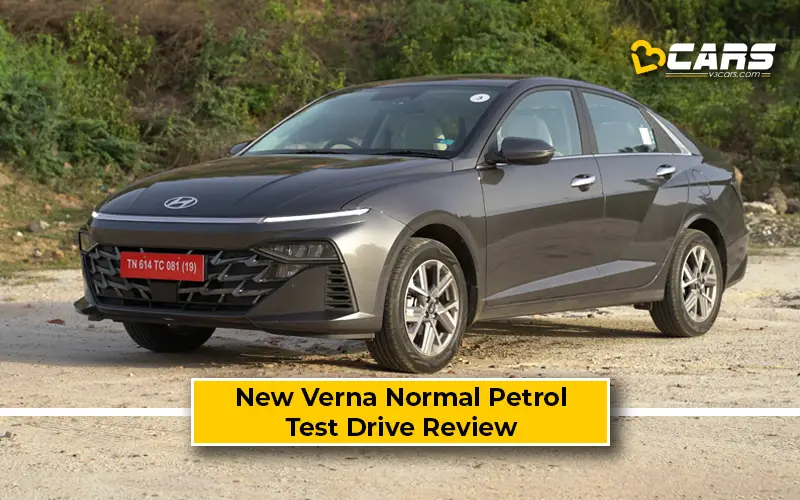
Note: If you prefer watching the review in Hindi instead of reading it in English, then you can play the following video:
Hyundai Verna Normal Petrol - Exterior Review
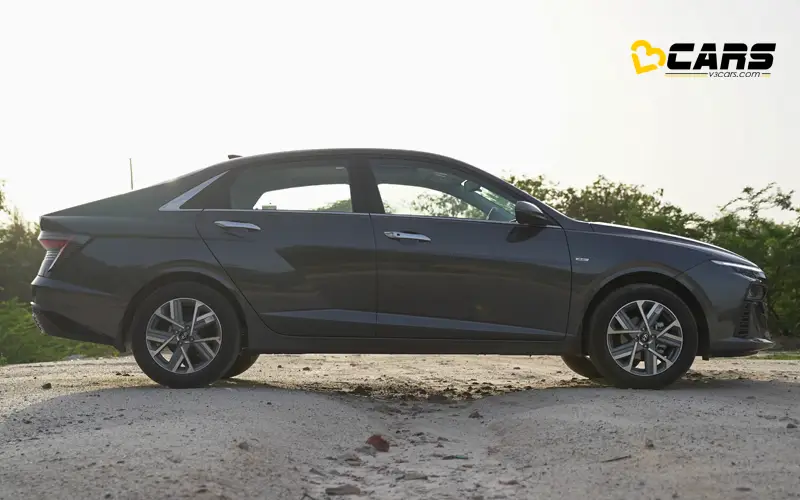
The best part of Verna's exterior design is its proportions. The car's tyre size, track and wheelbase complement its large dimensions, and in comparison to its rivals, it has a more appealing stance.
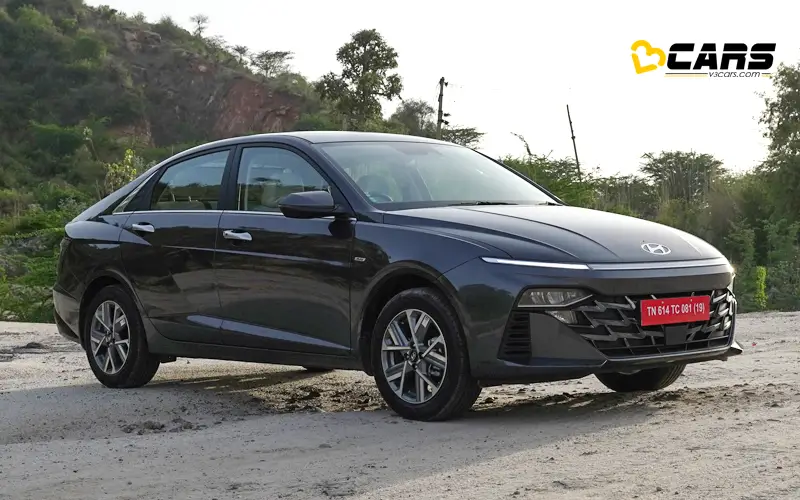
Apart from the proportions, Verna's exterior design has striking lightwork. Its front and rear lights are connected. The front has LED lights on the left and right sides that serve as DRLs, and the middle light only comes on after the parking lamp is turned on. Therefore, you can expect that only the side lights will be on during the daytime.
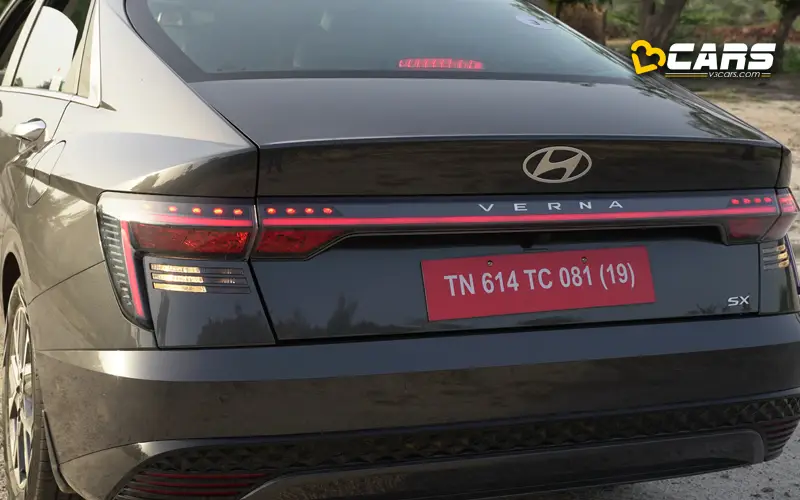
Similar to the front middle LED light, the rear connected light is also attached to the parking lamp. So when your front connected light is on, the rear light will accompany it. Speaking of the rear lights, its crystalline brake lights are quite attractive, and we believe that Verna's lights give it a unique appearance from the front and rear.
The only issue I have with Verna's lightwork is that it has regular bulb-type turn indicators all around. If they were LED type, they would better complement its modern exterior design.
Another highlight of Verna's exterior is its boot space, which can be opened hands-free. Its 528L luggage capacity is the highest in this segment. We can confidently say that it can easily accommodate the weekend luggage for five. Under its boot floor, there is a 15-inch spare steel wheel, and there is space around it to keep a puncture repair kit or a tyre inflator.
Now, before we talk about the interior, it is worth noting that Verna has a request sensor only on the driver's side, and its keyless entry works only on that side. Let's take a look at its interior.
Hyundai Verna Normal Petrol - Interior Front Review
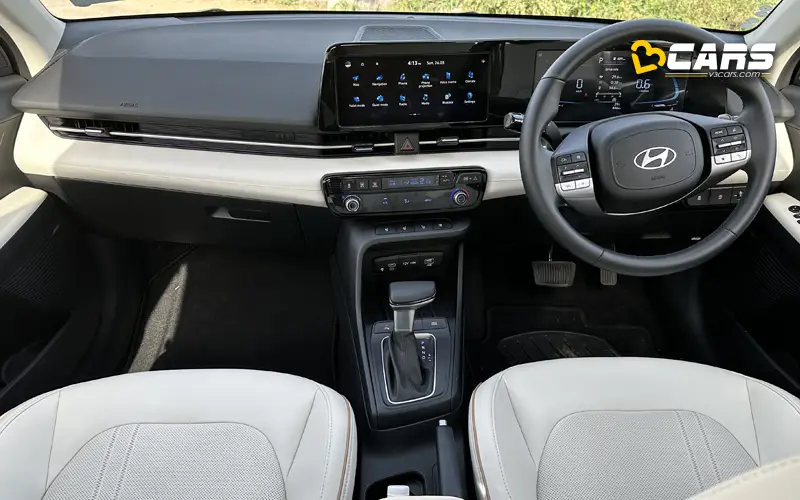
The non-turbo Verna has a dual-tone beige-black interior with high-quality plastic panel on the top of the dashboard and soft leather trim in the middle as well as on the doors. There is enough storage space in the front cabin area, including a place to wirelessly charge a phone. Moreover, the dashboard and the centre console has a slight tilt towards the driver side for convenience.
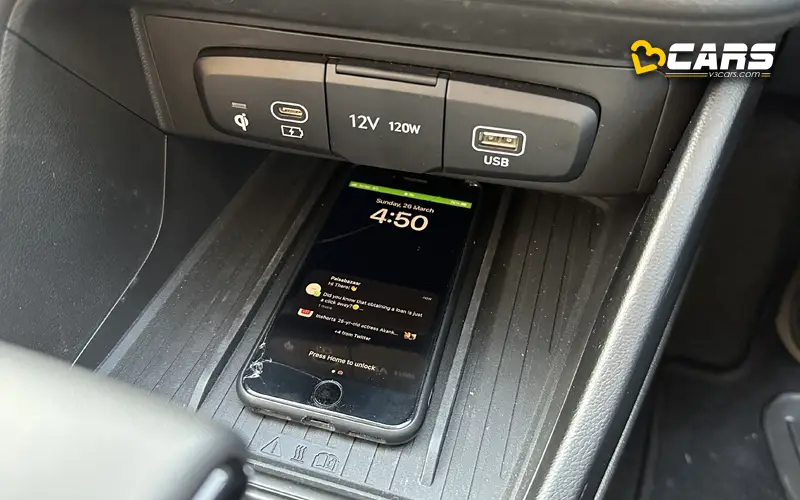
There is a multi-colour ambient light on its dashboard and doors with adjustable brightness from the infotainment system. You can not only link the ambient light to match the drive modes but also turn it off completely if you want a less flashy cabin experience.
Its AC has two unique features. Firstly, it has switchable controls for air conditioning and the infotainment system. Some viewers mentioned in our previous video that this was a cost-cutting measure because Hyundai did not have to install separate switches for both. Personally, I change air-con settings from the centre console and manage the infotainment from the steering-mounted controls. So, I didn’t find it cumbersome to toggle between the modes.
The second unique feature is three levels of auto AC. By operating this button, you can set the temperature of the AC and choose the blower speed according to your preference.
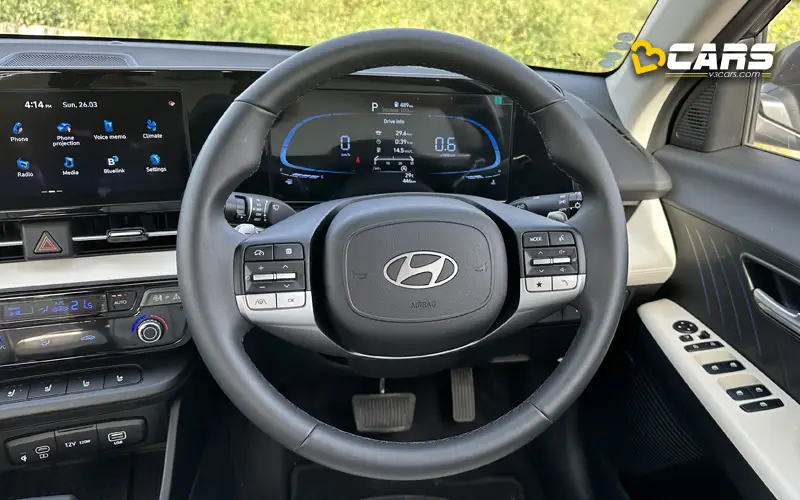
Now, let's talk about the second screen in the cabin – the instrument cluster. It has an MID in the middle, which displays the lane keep assist, tripmeter, compass and data from the tyre pressure monitoring system.
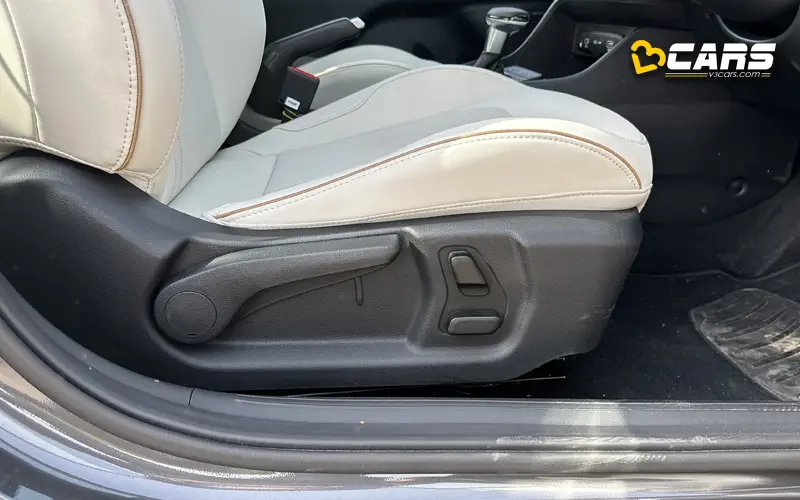
Talking about the driver's seat, it feels generous and comfortable, and the view from all sides is clear. This seat has electric slide and recline adjustment, which makes it even better. We wish it also had electric height adjustment. Now, let's move to the back seat.
Hyundai Verna Normal Petrol - Interior Rear Review
Like a typical sedan, the Verna’s roof line is quite low and its seats are quite deep. So, you sit close to the ground. Elderly people may find getting out of the rear seats a little difficult. However, once you're inside, the rear seat space is something everyone will appreciate. The front seat is currently adjusted according to a 5-feet 8-inch driver and I have more than adequate knee room and foot adjustment space under the driver's seat.
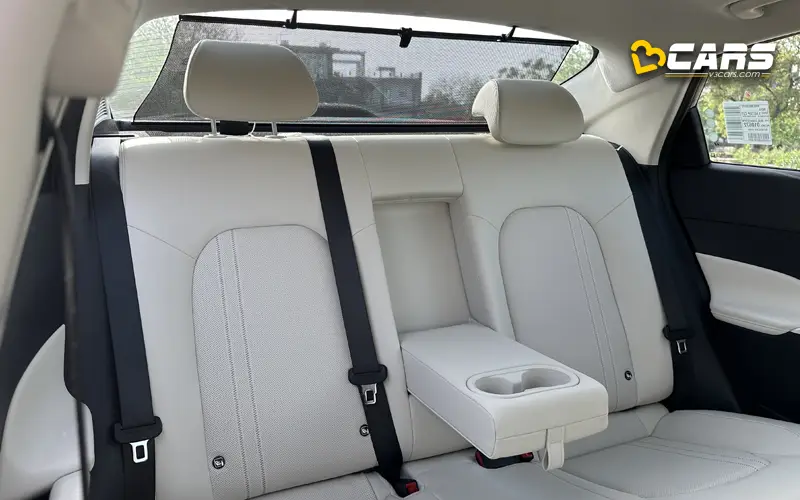
Besides the space, I also feel that the rear seat cushion offers balanced support - you’ll neither sink into it nor will you find it too stiff either. This is one of the better rear seats that I have sat in and I enjoyed travelling in the Verna’s rear seat. The rear seat back angle, underthigh space, cushion - everything is spot on for my tastes. If you are considering it from a rear seat perspective, we would recommend adding a removable pillow to the headrest for extra cushioning.
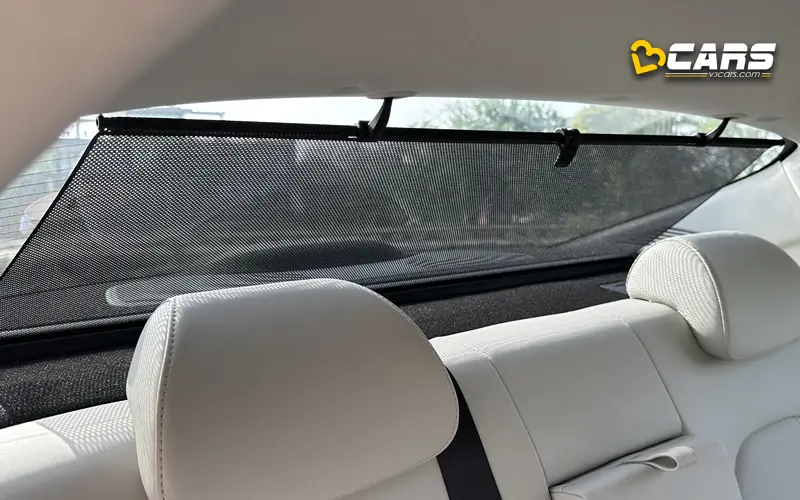
In terms of space, there is enough headroom for me, and I think the space is enough for passengers up to 6-feet tall. Talking about the features on offer for rear occupants, it gets notable ones like:
- Rear windshield curtain
- Adjustable headrests
- Rear armrest
- Rear AC vents
- USB-C ports
- Phone storage space
- Power windows
- Door pockets
Personally, I feel that this seat also deserves rear window curtains and dedicated reading lights.
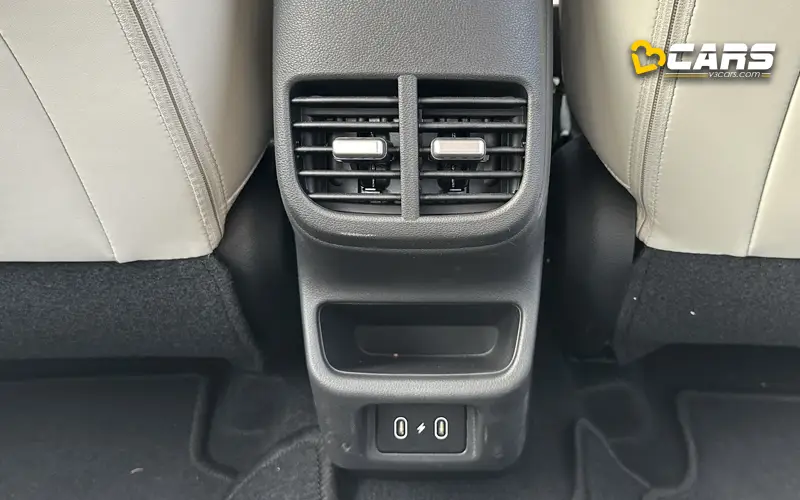
Overall, Verna's non-turbo beige-black cabin feels airy due to its light interior theme and is more upmarket compared to the turbo Verna. Its rear seat is so spacious and comfortable that we would strongly recommend it even to chauffeur-driven buyers.
Hyundai Verna 1.5L Normal Petrol-Automatic - Engine Performance And Drive
The Verna's 1.5-liter normal petrol engine produces a maximum power of 115PS and a peak torque of 144Nm. This same engine was already present in the Verna before and it’s a tried-and-tested powertrain. Along with the E20 fuel compatibility, it should offer good long-term reliability.
To test its outright performance, we also did a brief 0-100kmph test of the Verna, which it completed in around 12 seconds. It’s an acceptable figure considering its output - so it's neither fast nor slow.
Talking about roll-on acceleration, in that case, the engine feels stressed - in the way it sounds. This is mainly because of the CVT type automatic transmission, which revs the engine high, but its actual speed does not increase proportionally.
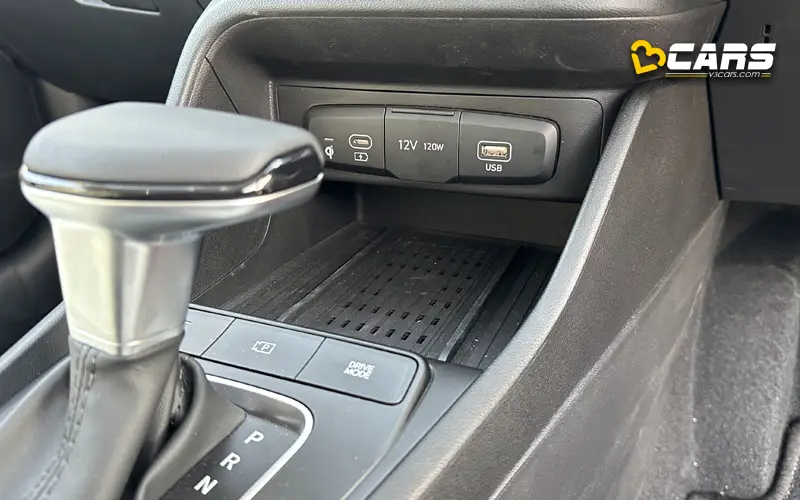
Hyundai claim a mileage figure of 18.60kmpl for the Verna normal petrol-manual and 19.60kmpl with the petrol-automatic. We did not have enough time to test the fuel efficiency of this car, but we will do so when we get the opportunity.
For the kind of performance it offers, we found Verna's braking satisfactory, although we would have liked some more initial bite in it. As far as its ride is concerned, it now has the right kind of stiffness, and it feels composed at most speeds. Even when going over potholes and speed breakers, the car feels stable and composed.
Overall, the Verna non-turbo felt adequately powerful to us from a relaxed driving perspective, and we think it easily fulfils the powertrain-related needs of most buyers. We think the Verna non-turbo is a comfortable car, so if ride comfort and relaxed powertrain performance are important to you, then you can shortlist the Verna non-turbo for these attributes. If you want to better understand the performance of the Verna turbo, we have a dedicated video on it, the link of which is in the description
Hyundai Verna Normal Petrol - Verdict And Buying Recommendation
The Verna starts with a non-turbo petrol engine at a price of Rs 10.90 lakh. The top SX (O) variant with a petrol-manual powertrain costs Rs 14.66 lakh. The SX and SX(O) variants also have an option for automatic transmission with the regular petrol engine, which costs an additional Rs 1.25 lakh for the SX variant and Rs 1.54 lakh for the SX Optional variant.
The normal petrol engine of Verna delivers satisfactory performance and we did not feel it was underpowered during our first drive.
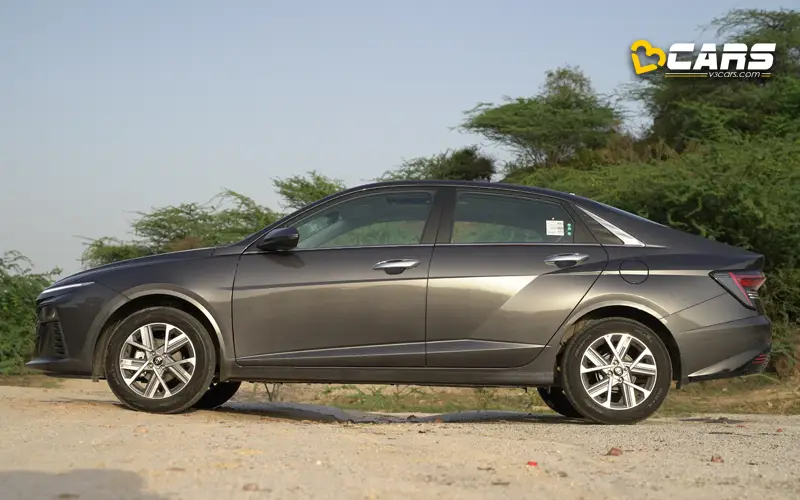
According to us, as a package, the Verna non-turbo is a striking sedan - easily one of the better-looking cars in its segment due to its appropriate proportions. Its second and important highlight is its rear seat, which is comfortable and spacious - it is so compelling that we think Verna is now one of the better packages to buy for rear seat focused buyers in this segment.
So, if you are planning to buy a value-centric family sedan or a C-segment car mainly for rear seat use, then Verna should be at the top of your list of priorities.
|
|
||||||||
|
|
|
|
|
|
||||
|
|
|
|
|
|
|
|
|
|
|
|
|
|
|
|
|
|
|
|
|
|
|
|
|
|
|
|
|
|
|
|
|
|
|
|
|
|
|
|
|
|
|
|
|
|
|
|
|
|
|
|
|
|
|
|
|
|
|
|
|
|
|
|
|
|
|
|
|
|
|
|
|
|
|
|
|
|
|
|
|
|
|
|
|
|
|
|
|
|
|
|
|
|
|
|
|
|
|
|
|
|
|
|
|
|
|
|
|
|
If you are chauffeur-driven and buying Verna mainly for the rear seat, then you can go for its S variant with a manual transmission - its ex-showroom price is marginally lower at Rs 12.0 lakh. If you also drive yourself and want to buy a family sedan, then go for its SX variant with automatic transmission. For more details on variant-wise features, you can watch our "variants explained" video below or read through the Hyundai Verna Variants Explained article.


0 Comments
Hyundai Cars in India
Venue
₹7.90 - ₹15.69 lakh*
*Ex-showroom priceVenue N
Line
₹10.55 - ₹15.48 lakh*
*Ex-showroom priceCreta EV
₹18.02 - ₹24.70 lakh*
*Ex-showroom priceAlcazar
₹14.47 - ₹21.10 lakh*
*Ex-showroom priceCreta N
Line
₹16.35 - ₹20.09 lakh*
*Ex-showroom priceCreta
₹10.79 - ₹20.20 lakh*
*Ex-showroom priceExter
₹5.49 - ₹9.61 lakh*
*Ex-showroom priceVerna
₹10.69 - ₹16.98 lakh*
*Ex-showroom priceAura
₹5.98 - ₹8.42 lakh*
*Ex-showroom priceGrand i10
Nios
₹5.47 - ₹7.92 lakh*
*Ex-showroom priceIoniq 5
₹46.30 lakh*
*Ex-showroom pricei20 N
Line
₹9.14 - ₹11.60 lakh*
*Ex-showroom pricei20
₹6.87 - ₹10.52 lakh*
*Ex-showroom priceUpcoming Hyundai Cars
Next-Gen Venue
N Line
₹11.40 - ₹13.30 lakh*
*Expected PriceExpected Launch Nov 2025
Next-Gen Venue
₹8.19 - ₹13.20 lakh*
*Expected PriceExpected Launch Nov 2025
Verna Facelift
₹11.10 - ₹17.99 lakh*
*Expected PriceExpected Launch Mar 2026
Exter Facelift
₹6.19 - ₹10.89 lakh*
*Expected PriceExpected Launch Jul 2026
Exter XRT
₹8.99 - ₹11.30 lakh*
*Expected PriceExpected Launch Dec 2026
Creta 3rd-Gen
₹11.49 - ₹21.50 lakh*
*Expected PriceExpected Launch Jan 2027
Next-Gen Grand
i10 Nios
₹6.30 - ₹8.99 lakh*
*Expected PriceExpected Launch Apr 2027
Next-Gen Aura
₹6.80 - ₹9.50 lakh*
*Expected PriceExpected Launch May 2027
Stargazer
-
*Expected PriceExpected Launch Jun 2027
Verna N
Line
-
*Expected PriceExpected Launch Jul 2027
Sonata Facelift
-
*Expected PriceExpected Launch Dec 2027
Ioniq 6
2026
₹65.00 - ₹80.00 lakh*
*Expected PriceExpected Launch Feb 2028
Kona EV
Facelift
-
*Expected PriceExpected Launch Feb 2028
Staria
₹45.00 - ₹55.00 lakh*
*Expected PriceExpected Launch Oct 2028
Venue XRT
₹12.49 lakh*
*Expected PriceExpected Launch Nov 2028
Next Gen
Elantra
-
*Expected PriceExpected Launch Dec 2028
Palisade
-
*Expected PriceExpected Launch Jan 2029
Venue Facelift
-
*Expected PriceExpected Launch Mar 2029
Ioniq 5
Facelift
-
*Expected PriceExpected Launch Apr 2029
Santa FE
-
*Expected PriceExpected Launch Apr 2029
Ioniq 9
₹80.00 - ₹90.00 lakh*
*Expected PriceExpected Launch Jun 2029
Nexo
-
*Expected PriceExpected Launch Feb 2030
Latest Hyundai Cars Videos
Hyundai Venue vs Maruti Arena Brezza Sub Rs. 10 Lakh Battle | Which Car Is More Value For Money?
Hyundai Venue vs Tata Nexon Sub Rs. 11 Lakh Battle | Which Car Is More Value For Money?
Hyundai Venue vs Tata Nexon Sub Rs. 12 Lakh Battle | Which Car Is More Value For Money?
Hyundai Venue vs Tata Nexon Sub Rs. 9 Lakh Battle | Which Car Is More Value For Money?
Hyundai Verna 1.5 Turbo DCT Fuel Efficiency Test | Real-World Mileage Review
Hyundai Venue vs Tata Nexon | Sub Rs. 8 Lakh Battle | Which Car Is More Value For Money?
New Hyundai Venue Variants Explained | HX2, HX4, HX5, HX6, HX6T, HX8, HX10, N6, N10
Tata Punch vs Hyundai Exter Sub Rs. 10 Lakh Battle | Which Car Is More Value For Money?
Hyundai Exter vs Tata Punch | Sub Rs. 7 Lakh Battle | Which Car Is More Value For Money?
Kia Seltos vs Hyundai Creta | Sub Rs 15 Lakh Battle | Which Car Is More Value For Money?
Verna Important Links